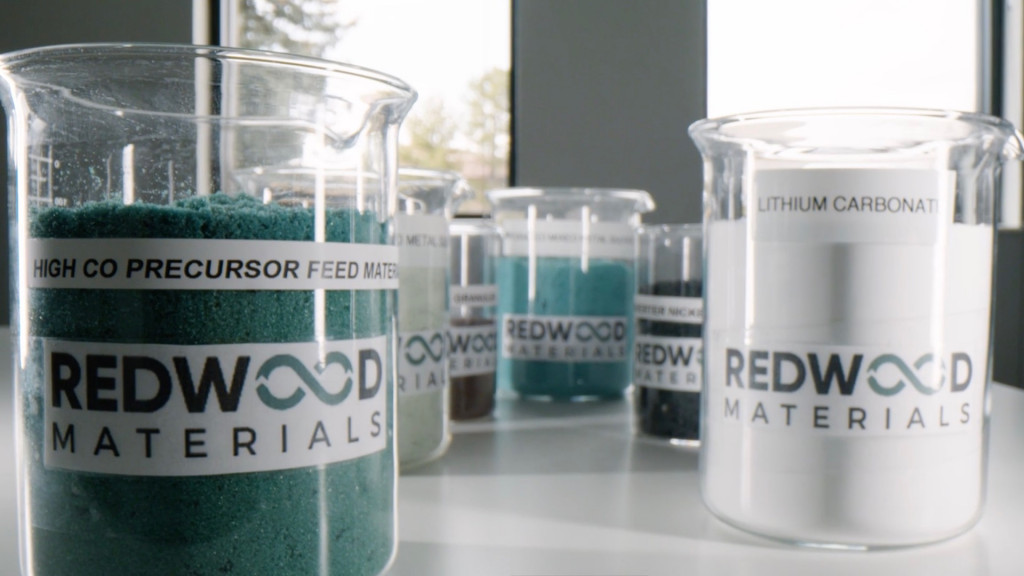Typically, electric vehicle battery packs are lasting longer—and for more miles—than originally intended.
According to former Tesla CTO and co-founder JB Straubel, EV battery packs should last about 15 years—a key piece for the timeline as Straubel’s current venture, Redwood Materials, ramps up as part of a supply chain for recycled materials for EV batteries.
Currently, most EV battery warranties or assurances are far less than that, though. One of the boldest claims is that from Toyota and its upcoming bZ4X—that it will retain 90% of its battery capacity after 10 years of ownership
Tesla CTO JB Straubel and CEO Elon Musk presenting at gigafactory tour, Reno, Nevada, July 2016
Last May, California proposed a durability and battery degradation requirement: that EV batteries for the 2026 model year and later maintain 80% of their original range for 15 years or 150,000 miles. In a draft form of the regulation released by CARB in December, that requirement was greatly reduced after the petition of automakers—to 80% for eight years or 100,000 miles, whichever comes first.
The battery comment was just a small part of an interview conducted earlier this month by author and energy expert Daniel Yergin, as part of IHS Markit’s CERAWeek 2022,
In it, Redwood CEO Straubel emphasized that the raw materials that go into EV batteries are different. They’re needed, but they’re not actually consumed, so the whole supply chain needs to be reconceived around a closed loop and something close to a full recovery.

Redwood Materials
Between 50% and 70% of the cost of the lithium-ion battery are in the “strategic materials,” he explained, not the manufacturing, and for that reason Moore’s law doesn’t apply to batteries. He noted that recycling is going to be the future for how nearly all the material moves, and cost reductions in that logistics chain are the key to battery cost reductions.
Straubel also emphasized that it’s quite different than recycling the plastic bottles in your kitchen. Redwood is looking at how to link the recycling directly back to manufacturing.
Visiting mines and seeing the scale and immensity of the challenge that goes into increasing their capacity by an order of magnitude helped Straubel realize the burden—and the need for recovered materials to achieve scale for an electric vehicle supply chain, he explained.

Redwood Materials
“We have to basically build an un-manufacturing infrastructure of the same scale that we had to build to make them in the first place,” he emphasized. Currently Redwood is processing in the range of 8-10 GWh per year—enough for batteries for hundreds of thousands of EVs—even though, according to market research firm Wood Mackenzie, the industry around battery recycling won’t see exponential growth until 2030.
Redwood has already faced some challenges—finding enough experts in electrochemistry and metallurgy, fields that have largely moved overseas. And the automation of sorting various types of batteries and chemistries is especially challenging.
Straubel notes that the target customer is changing, too, as a result of the scramble for securing the supply chain. While a few years ago the customers might have been cathode makers or battery makers, now because of strategic materials needs their customers could be the OEMs like Ford—who, in turn, could be buying back the materials from their vehicles’ battery packs.
We’ve embedded the interview below, and it’s well worth the time.

generic lasuna – buy lasuna paypal himcolin generic
generic besivance – buy generic carbocysteine for sale generic sildamax
order gabapentin 600mg generic – cost sulfasalazine 500mg buy azulfidine 500mg pill
colospa online order – mebeverine 135mg canada brand cilostazol
buy celecoxib 100mg pills – celecoxib 100mg canada oral indomethacin 50mg
order rumalaya online cheap – rumalaya online buy purchase elavil pills
order voltaren 50mg generic – buy aspirin 75mg pill aspirin 75 mg us
buy pyridostigmine 60mg generic – buy mestinon 60 mg pills azathioprine for sale online
order voveran generic – diclofenac online order cheap nimotop without prescription
buy generic baclofen 10mg – baclofen 10mg canada purchase piroxicam without prescription
meloxicam cheap – maxalt 5mg ca buy ketorolac
generic cyproheptadine 4 mg – buy zanaflex generic where can i buy zanaflex
artane cheap – purchase artane online voltaren gel where to buy
order isotretinoin 20mg generic – buy dapsone 100mg deltasone over the counter
flagyl 200mg tablet – order cenforce 50mg online order cenforce 50mg online cheap
buy generic betnovate – monobenzone for sale online order monobenzone without prescription
buy generic augmentin – synthroid for sale oral levothyroxine
cleocin online buy – oral clindamycin buy indocin pills for sale
buy eurax without a prescription – aczone for sale buy aczone sale
cozaar 50mg sale – order keflex pills order generic keflex 125mg
buy generic bupropion online – orlistat online buy buy generic shuddha guggulu
provigil 100mg generic – promethazine usa melatonin 3mg drug
progesterone 200mg ca – purchase clomid online cheap fertomid price
order xeloda 500mg generic – where to buy mefenamic acid without a prescription danazol online
cost alendronate 70mg – order generic provera 10mg buy generic provera 10mg
purchase cabergoline sale – purchase alesse pill alesse online
estradiol pills – buy yasmin pills for sale order arimidex 1mg pills
гѓ—гѓ¬гѓ‰гѓ‹гѓігЃ®иіје…Ґ – гѓ—гѓ¬гѓ‰гѓ‹гѓі – 5mg г‚ўг‚ёг‚№гѓгѓћг‚¤г‚·гѓі е‰ЇдЅњз”Ё
valif online frog – valif online father order sinemet pill
order modafinil 100mg for sale – buy epivir generic where can i buy lamivudine
ivermectin stromectol – stromectol coronavirus tegretol 200mg price
promethazine pill – lincocin over the counter lincomycin 500mg ca
buy prednisone 20mg without prescription – order prednisone generic cost captopril
accutane pill – buy zyvox 600mg generic order zyvox
purchase amoxicillin online – buy valsartan 160mg purchase combivent for sale
azithromycin 250mg us – buy azithromycin 500mg pill bystolic uk
how to get omnacortil without a prescription – omnacortil us purchase progesterone
neurontin online buy – sporanox 100 mg pills order itraconazole 100mg online cheap